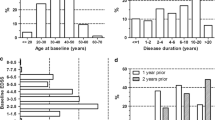Abstract
We reported a post-marketing experience of 190 patients affected by relapsing multiple sclerosis on treatment with natalizumab. Clinical findings during pre-treatment period and throughout the study were documented. Magnetic resonance imaging (MRI) scans were performed at baseline and at 6, 12, and 24 months of therapy. Cumulative proportions of patients disease activity free (i.e. absence of relapses, disability progression, MRI activity) were measured as efficacy endpoints. Despite that the baseline characteristics suggested a more severe course of disease in our sample than that of the AFFIRM trial, data on effectiveness of natalizumab were comparable. At 1 year of treatment we found 80 and 70% patients free from relapses and MRI activity, respectively, that is similar to 75 and 62% detected in the AFFIRM trial. Moreover, only 5% of our patients showed a progression of disability after a mean follow-up time of 15 months. Finally, the presence of antibodies anti-Natalizumab was strongly related to the occurrence of relapses (p = 0.002) and MRI activity (p < 0.001) even in the post-marketing experience.

Similar content being viewed by others
References
Yednock TA, Cannon C, Fritz LC et al (1992) Prevention of experimental autoimmune encephalomyelitis by antibodies against alpha 4 beta 1 integrins. Nature 356:63–66
Polman CH, O’Connor PW, Havrdova E et al (2006) A randomized, placebo-controlled trial of natalizumab for relapsing multiple sclerosis. N Engl J Med 354:899–910
Havrdova E, Galetta S, Hutchinson M et al (2009) Effect of natalizumab on clinical and radiological disease activity in multiple sclerosis: a retrospective analysis of the natalizumab safety and efficacy in relapsing-remitting multiple sclerosis (AFFIRM) study. Lancet Neurol 8:254–260
Rudick RA, Stuart WH, Calabresi PA et al (2006) Natalizumab plus Interferon Beta-1a for Relapsing Multiple Sclerosis. N Engl J Med 354:911–923
Hartung HP (2009) New cases of progressive multifocal leukoencephalopathy after treatment with natalizumab. Lancet Neurol 8:28–31
McDonald WI, Compston A, Edan G et al (2001) Recommended diagnostic criteria for multiple sclerosis: guidelines from the International Panel on the diagnosis of multiple sclerosis. Ann Neurol 50:121–127
Kurtzke JF (1993) Rating neurological impairment in multiple sclerosis: an Expanded Disability Status Scale (EDSS). Neurology 33:1444–1452
Miller DH, Albert PS, Barkhof F et al (1996) Guidelines for the use of magnetic resonance techniques in monitoring the treatment of multiple sclerosis US National MS Society Task Force. Ann Neurol 39:6–16
http://www.biogenidec.com/site/tysabri-information-center.html (last accessed on 22 March 2010)
Oturai AB, Koch-Henriksen N, Petersen T et al (2009) Efficacy of natalizumab in multiple sclerosis patients with high disease activity: a Danish nationwide study. Eur J Neurol 16:420–423
Putzki N, Yaldizli O, Mäurer M et al (2009) Efficacy of natalizumab in second-line therapy of relapsing-remitting multiple sclerosis: results from a multi-center study in German speaking countries. Eur J Neurol 17:31–37
Outteryck O, Ongagna JC, Zéphir H et al (2010) Demographic and clinic characteristics of French patients treated with natalizumab in clinical practice. J Neurol 257:207–211
Hutchinson M, Kappos L, Calabresi PA et al (2009) The efficacy of natalizumab in patients with relapsing multiple sclerosis: subgroup analyses of AFFIRM and SENTINEL. J Neurol 256:405–415
Calabresi PA, Giovannoni G, Confavreux C et al (2007) The incidence and significance of anti-natalizumab antibodies: results from AFFIRM and SENTINEL. Neurology 69:1391–1403
Kappos L, Bates D, Hartung HP et al (2007) Natalizumab treatment for multiple sclerosis: recommendations for patient selection and monitoring. Lancet Neurol 6:431–441
Dorsey ER, Thompson JP, Noyes K et al (2007) Quantifying the risks and benefits of natalizumab in relapsing multiple sclerosis. Neurology 68:1524–1528
Tedeschi G, Amato MP, D’Alessando R et al (2009) The pharmacovigilance program on natalizumab in Italy: 2 years of experience. Neurol Sci 30(Suppl 2):S163–S165
Conflict of interest statement
Dr. Prosperini, Dr. Borriello, Dr. Marinelli, and Dr. Fubelli do not have any disclosures to report. Prof. Pozzilli has received honoraria for consultancy or speaking from Sanofi Aventis, Biogen, Bayer Schering, Merck Serono, and Novartis and has received research grants from Sanofi Aventis, Merck Serono, and Bayer Schering.
Author information
Authors and Affiliations
Corresponding author
Rights and permissions
About this article
Cite this article
Prosperini, L., Borriello, G., Fubelli, F. et al. Natalizumab treatment in multiple sclerosis: the experience of S. Andrea MS Centre in Rome. Neurol Sci 31 (Suppl 3), 303–307 (2011). https://doi.org/10.1007/s10072-010-0348-8
Published:
Issue Date:
DOI: https://doi.org/10.1007/s10072-010-0348-8




